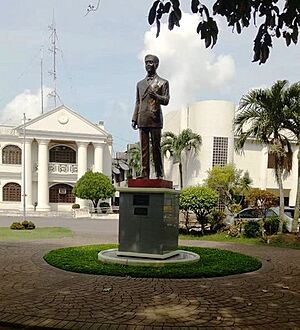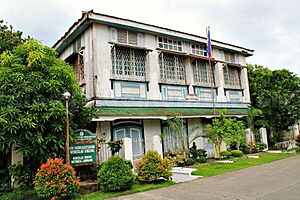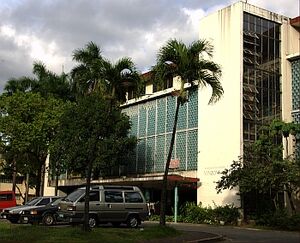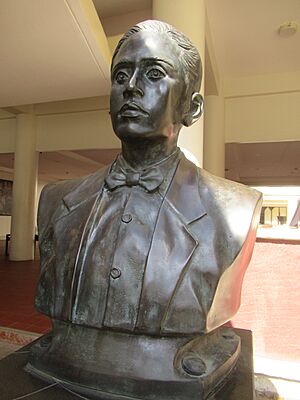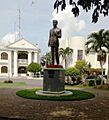Wenceslao Vinzons facts for kids
Quick facts for kids
Wenceslao Q. Vinzons, Sr.
|
|
|---|---|
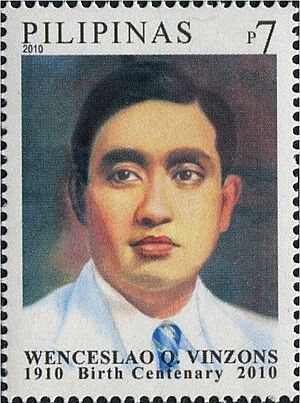
Vinzons on a 2010 stamp of the Philippines
|
|
| Member of the Philippine House of Representatives from Camarines Norte's Lone District | |
| Died before taking office | |
| Governor of Camarines Norte | |
| In office December 30, 1940 – December 30, 1941 |
|
| Preceded by | Miguel Lukban |
| Succeeded by | Basilio Bautista Sr. |
| Member of the 1934 Philippine Constitutional Convention from Camarines Norte | |
| In office July 10, 1934 – November 15, 1935 |
|
| Personal details | |
| Born |
Wenceslao Quinito Vinzons
September 28, 1910 Indan, Camarines Norte, Philippine Islands |
| Died | July 15, 1942 (aged 31) Daet, Camarines Norte, Philippines |
| Political party | Young Philippines |
| Spouse | Liwayway Custodio Gonzales |
| Children | 5 |
| Parents | Gabino Vinzons (father) Engracia Quinito (mother) |
| Alma mater | University of the Philippines University of the Philippines College of Law (LL.B) |
| Occupation | Politician |
| Profession | Lawyer, activist |
| Known for | "Father of Student Activism in the Philippines" |
Wenceslao "Bintao" Quinito Vinzons Sr. (born September 28, 1910 – died July 15, 1942) was a brave Filipino hero. He led the fight against the Japanese invasion during World War II. He was also the youngest person to join the 1935 Philippine Constitutional Convention.
As a student leader, he was called the "Father of Student Activism in the Philippines." This was because he led many demonstrations. He also helped start the Young Philippines Party with Narciso J. Alegre and Arturo M. Tolentino.
Vinzons was one of the first Filipinos to create a guerrilla group. This happened when the Japanese invaded the Philippines in 1941. Sadly, he was captured and executed by the Japanese army during the war.
Contents
Early Life and Education
Vinzons was born in a town called Indan in Camarines Norte. His parents were Gavino Vinzons and Engracia Quinito. He was baptized on October 5, 1910.
He was the top student when he finished high school. After that, he went to the University of the Philippines in Manila.
Becoming a Student Leader
While at the university, Vinzons became a famous student leader. He was elected president of the student council. He also became the editor-in-chief of the Philippine Collegian, which is the university's newspaper.
Vinzons was also known for a speech called Malaysia Irredenta. In this speech, he talked about uniting Southeast Asian nations. He believed they shared a common Malay origin. This speech won him a special award.
In 1932, Vinzons earned his law degree. The next year, he placed 3rd in the bar examinations. This meant he was one of the best new lawyers.
Political Career and Public Service
After finishing his studies, Vinzons started a political party. He formed the Young Philippines party with Narciso J. Alegre and Arturo M. Tolentino. This party wanted the Philippines to become independent from American rule.
Joining the Constitutional Convention
In 1934, a law was passed to prepare the Philippines for independence. Vinzons was elected to represent Camarines Norte in the 1935 Constitutional Convention. This group wrote the new Philippine Constitution.
Vinzons helped make Tagalog an official language of the Philippines. He was only 24 years old. This made him the youngest person to sign the 1935 Constitution.
Serving as Governor and Congressman
In the 1935 presidential elections, Vinzons supported Emilio Aguinaldo. Aguinaldo was a former president of the Philippine Revolutionary Government. Even though Aguinaldo lost, Vinzons helped him win in Camarines.
After this, Vinzons took a break from politics. He became the president of a mining company.
He returned to politics in 1940. He was elected governor of Camarines Norte. The next year, he was elected to the House of Representatives of the Philippines. He was supposed to represent Camarines Norte. However, the Japanese invasion in December 1941 stopped him from serving.
Leading the Resistance and His Sacrifice
When the Japanese forces arrived in the Philippines, Vinzons quickly organized a resistance. He gathered armed groups in the Bicol Region to fight the invaders. He took control of rice warehouses and used explosives from gold mines against the Japanese.
Fighting the Japanese Army
By December 18, 1941, Vinzons led a raid against Japanese soldiers. His group of fighters grew to about 2,800 strong. In May 1942, Vinzons led his forces to free the provincial capital of Daet.
It is said that between December 1941 and May 1942, Vinzons' troops killed many Japanese soldiers. They used weapons like poisoned arrows. Because of this, the Japanese army made capturing Vinzons their main goal.
Capture and Execution
A former guerrilla fighter betrayed Vinzons. On July 8, 1942, the Japanese military captured him and his father. Vinzons refused to cooperate with his captors. He was taken to a military base in Daet.
On July 15, 1942, Vinzons was killed after he refused one last time to work with the Japanese. Soon after, his father, wife, sister, and two of his children were also executed by the Japanese.
Lasting Legacy
Vinzons is remembered as the "Father of Student Activism in the Philippines".
His hometown, Indan, was renamed Vinzons in his honor. An elementary school in Manila was also named after him. In 1959, the student activity center at the University of the Philippines, Diliman campus was named Vinzons Hall. This building also holds the offices of the Philippine Collegian.
Some of Vinzons' relatives also became politicians. His son was once a governor. His daughter was a member of the Provincial Council.
A musical about Vinzons' life, called "Bintao", was performed in 2008 and again in 2018.
Images for kids


